 enquiry@ajaybio.in
enquiry@ajaybio.in Call Us: 020-67111010
Call Us: 020-67111010

Biofertilizer contains living micro-organisms which, when applied to soil, colonizes the rhizosphere or the interior of the plant and promotes growth by increasing the availability of primary nutrients to the host plant. Biofertilizers contain living or latent cells of efficient strains of microorganisms. They are eco-friendly. These can also be called as "Live Fertilizer" and most commonly used in Organic Farming/Agriculture for nutrient availability. It increases crop yield by 20-30%, replaces chemical nitrogen and phosphorus by 30%, and stimulates plant growth. It can also provide protection against drought and some soil-borne diseases.
Nowadays biofertilizers have become the best innovative solution to improve soil health and soil fertility. Those are the substances containing variety of microbes having the capacity to enhance plant nutrient uptake by colonizing the rhizosphere and make the nutrients easily accessible to plant root hairs. Biofertilizers are well known for their cost effectiveness, environment-friendly nature and composition. These are effective alternatives to the hazardous synthetic / chemical fertilizers.
Biofertilizers are required to restore the fertility of the soil. Prolonged use of chemical fertilizers degrades the soil living organism, soil pH, organic carbon and affects crop yield. Biofertilizers, on the other hand, enhance the water holding capacity of the soil and add essential nutrients such as nitrogen, vitamins and proteins to the soil. They are the natural form of fertilizers and hence, widely used in agriculture.
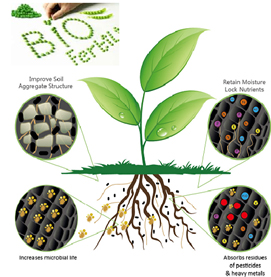
1. Enrich the soil with micro-organisms to produce organic nutrients.
2. Add nutrients through the natural processes like:
i. Nitrogen fixation.
ii. Solubilizing phosphorus.
iii. Synthesis of growth promoting substances.
iv. Produce hormone and anti-metabolites to promote root growth.
3. Accelerate microbial processes which cause:
i. Soil augmentation/ Soil mineralization.
ii. Availability of easily assimilated plants nutrients.
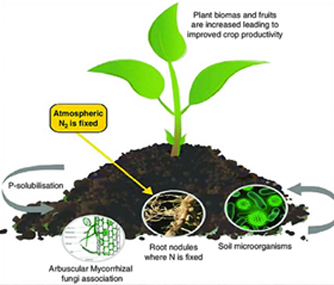
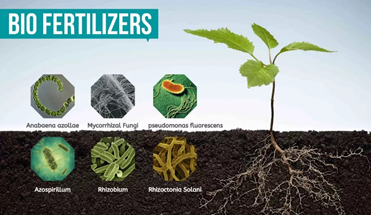
1. Nitrogen Fixing Biofertilizers
a. Symbiotic Nitrogen-Fixing Bacteria - Rhizobium
b. A loose association of Nitrogen Fixing Bacteria -Azospirillum
c. Symbiotic Nitrogen Fixing Cyanobacteria – Cyanobacteria/ Blue Green Algae
d. Free-Living Nitrogen-Fixing Bacteria - Azotobacter
2. Phosphate Biofertilizers
a. Phosphorous Solubilizing Biofertilizers
b. Potassium Mobilizing Biofertilizers
3. Biofertilizers for Micro-nutrients
4. Plant Growth Promoting Rhizobacteria
5. Compost
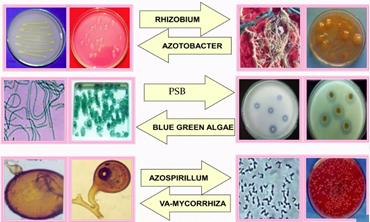
We Ajay Bio-Tech envisioned to provide quality products from our highly equipped DSIR lab with result-oriented products. We strongly believe in our brand BIOFIX as a best-in-class for organic farming and highly rewarding for all its consumer using it. It is a trusted brand of farmers in India for over 32 years. We have below bio-fertilizer products range:
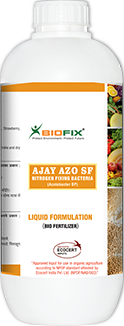
• It fixes atmospheric nitrogen and makes it available to plants.
• It plays an important role in the nitrogen cycle in nature, binding atmospheric nitrogen which is inaccessible to plants and releasing it in the form of ammonium ions into the soil.
• It increases vegetative growth, number and length of lateral roots as well as root area.
• Azotobacter colonization is mainly on the root surface which enhances mineral and water uptake.
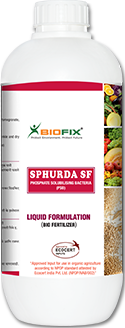
• Improves the Phosphate (P) availability to agricultural crops.
• It improves the plant's vigor and health.
• It is used got growth of plants becomes faster. Plant improves branching and makes better and deeper root system.
• It increases number of fruits and flowers which results in an increase in crop production.
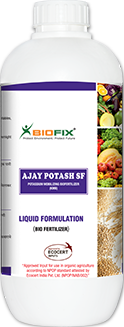
• It increases the availability of more potash in usable form to the plants.
• Play a key role in the natural potassium cycle, it dissolves potassium, silicon & aluminium from minerals that are present in the soil.
• It improves soil fertility with better immune system.
• It improves water retention, taste, colour, texture, yield, and disease resistance of the crop.

• This helps in the absorption of water, other essential macro and micro elements and Phosphorus solubilization and makes them available to the plants in consumable form.
• It gives vigorous white root growth and helps in plant growth and yield development.
• It restores soil moisture through its vast network of Arbuscules and Vesicles and also imparts plant metabolic activities.
• Makes the plant less susceptible to soil-borne pathogens and improves soil quality, nutrient cycling, and prevents soil erosion.
• It decreases mortality rate after transplantation of plants.